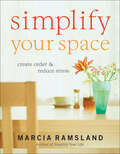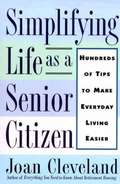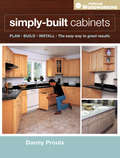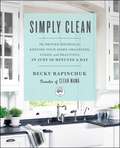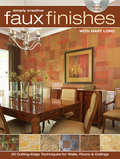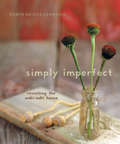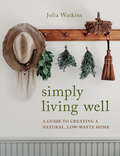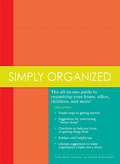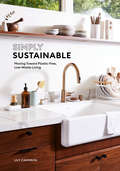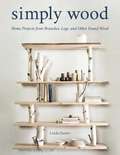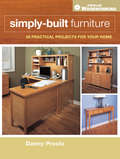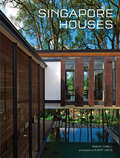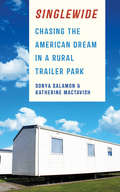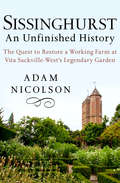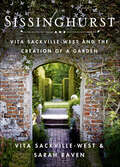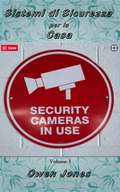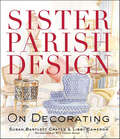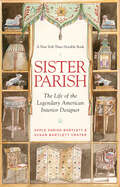- Table View
- List View
Simplify Your Space: Create Order & Reduce Stress
by Marcia RamslandPractical tips for organizing the spaces in your home help meet the needs for order in life.Would you like to clear out some of the clutter in your home? Do you ever wonder where all this stuff has come from feeling like things have maybe gotten a bit out of control? Join Marcia Ramsland, the organizing pro, as she leads you in a room-by-room approach to simplifying your home and office. Simplifying your space is the process of organizing your belongings and letting go of the excess until your surroundings are peaceful and in order. Using the CALM approach; C=Create a Plan, A=Approach it by Sections, L=Lighten up and Let Go, and M=Manage it Simply; Marcia guides readers in creating a more stress-free life. Includes 52 space saving tips, checklists, helpful diagrams, and even decorating ideas!
Simplifying Life as a Senior Citizen: Hundreds of Tips to Make Everyday Living Easier
by Joan ClevelandProviding solutions for common problems that afflict the daily lives of the elderly, this book presents information to help readers save time, money, frustration, and pain. Includes chapters of tips for managing vision loss, hearing loss and loss of mobility. The book provides chapters of easily read one-line tips that address a variety of broad as well as specific situations.
Simply Built Cabinets
by Danny ProulxYes, cabinets are those things that make up the storage in a kitchen. And they are the built-in storage spaces in your bathroom, den and other rooms. But cabinets are also free-standing storage units like bookcases. Building cabinets is really building boxes and there are simple techniques to create solid, quality cabinets that look great.Learn easy steps for making doors and drawers for your cabinets; how to make counter tops, install hardware and more.
Simply Clean: The Proven Method for Keeping Your Home Organized, Clean, and Beautiful in Just 10 Minutes a Day
by Becky RapinchukFrom the cleaning and homekeeping expert and creator of the wildly popular Clean Mama blog comes a simple and accessible cleaning guide with a proven step-by-step schedule for tidying a home in just ten minutes a day.Becky Rapinchuk, the “Clean Mama,” understands that many people don’t have the time, organizational skills, or homemaking habits to maintain a constantly clean and decluttered living space. In Simply Clean, Becky will help you effortlessly keep a tidy house and build habits to become a neat person—no matter how messy you may naturally be! Simply Clean features: -A 7-Day Simply Clean Kick Start and the 28-Day Simply Clean Challenge, to turn cleaning from a chore into an effortless habit -A designated catch-up day, so you’ll never have to worry or stress when life gets in the way of cleaning -Step-by-step tutorials for speed cleaning hard-to-clean spaces -Dozens of recipes for organic, environmentally conscious cleaning supplies -Many of Becky’s famous checklists, schedules, and habit trackers No matter how big your home or busy your schedule, the Simply Clean method can be customized to fit your life. It really is possible—in just ten minutes a day, you can create a cleaner, happier home.
Simply Creative Faux Finishes with Gary Lord: 30 Cutting Edge Techniques for Walls, Floors and Ceilings
by Gary LordSophisticated Home Decor Made Easy Nothing can transform a room quite like paint! In this groundbreaking guide, professional decorative painter Gary Lord presents 30 brand-new finishes for your walls, floors, ceilings and furniture. Designed by Gary and 23 of the top names in the industry, these cutting-edge finishes bring style, sophistication and value to every part of your home. Each project shows you step by step how to use the newest tools and painting products on the market to achieve elegant, updated home décor without the expense of hiring a professional. Everything you need to do-it-yourself successfully is included, such as: Complete lists of tools and materials Large, full-color step-by-step photos Tips from the pros that help you customize your project and avoid mistakes Detailed instructions for room and surface preparation Inspiring photos of completed projects in actual homes Whether you're a seasoned home decorator or a novice faux finisher, with this guide you'll have the inspiration and knowledge it takes to create a truly unique and beautiful home. Best of all, the designers featured here keep you ahead of the curve with their up-to-the-minute styles and techniques. From floors and walls to ceilings and beyond, make your home the best it can be. Please note that the digital version of this book does not include the bonus DVD.
Simply Imperfect: Revisiting the Wabi-Sabi House
by Robyn Griggs LawrenceThis revised and updated edition of The Wabi-Sabi House recounts the history of this aesthetic philosophy and reveals ways to introduce it into your home. The ancient Japanese philosophy of wabi-sabi is about appreciating simplicity and letting go of the superficial—the perfect antidote to modern consumerism and perfectionism. In 2004, author Robyn Griggs Lawrence helped popularize wabi-sabi in North America with her book The Wabi-Sabi House. In Simply Imperfect, Lawrence shows that wabi-sabi is far more than a style of home décor. It&’s a state of mind—a way of living modestly in the moment, stripping away the unnecessary, and finding satisfaction in everyday things. Tracing the rich history of wabi-sabi from its Zen Buddhist roots to the present day, this beautifully-illustrated book also offers tips on: Clearing clutter and blocking noiseIntegrating salvaged and recycled materialsMaking and growing things yourself (or supporting local artisans who do)Taking time and space for self-reflection
Simply Living Well: A Guide to Creating a Natural, Low-Waste Home
by Julia WatkinsRecipes, DIY projects, and inspiration for a beautiful and low-waste life, from the creator of @simply.living.well on Instagram In this timely and motivational guide, author Julia Watkins shares rituals, recipes, and projects for living simply and sustainably at home. For every area of your household—kitchen, cleaning, wellness, bath, and garden—Julia shows you how to eliminate wasteful packaging, harmful ingredients, and disposable items. Practical checklists outline easy swaps (instead of disposable sponges, opt for biodegradable sponges or Swedish dishcloths; choose a bamboo toothbrush over a plastic one) and sustainable upgrades for common household tools and products. Projects include scrap apple cider vinegar, wool dryer balls, kitchen bowl covers and cloth produce bags, non-toxic dryer sheets, all-purpose citrus cleaner, herbal tinctures and balms, and more, plus recipes for package-free essentials like homemade nut milk, hummus, ketchup, salad dressings, and veggie stock.
Simply Organized
by Jenny Schroedel Iyna Bort CarusoAre you living in cramped quarters with no space to breathe? Do you feel overwhelmed by all that clutter? You're not alone. Inside you'll find page after page of hints, tips, and strategies that help you set up and organize a home office anywhere, maximize closet and shelf space, sell what you no longer need or want, tuck away kitchen utensils in hidden storage spaces, and so much more. This book proves that you can live large in even the smallest of spaces by making every square inch count. It's simple! Getting organized doesn't have to take days or enormous amounts of effort. And think of how relieved you'll be once you put your house in order.
Simply Organized
by Iyna Bort CarusoAre you living in cramped quarters with no space to breathe? Do you feel overwhelmed by all that clutter? You're not alone.Inside you'll find page after page of hints, tips, and strategies that help you set up and organize a home office anywhere, maximize closet and shelf space, sell what you no longer need or want, tuck away kitchen utensils in hidden storage spaces, and so much more.This book proves that you can live large in even the smallest of spaces by making every square inch count. It's simple! Getting organized doesn't have to take days or enormous amounts of effort. And think of how relieved you'll be once you put your house in order.
Simply Organized: The all-in-one guide to organizing your home, office, children, and more!
by Iyna Bort CarusoAre you living in cramped quarters with no space to breathe? Do you feel overwhelmed by all that clutter? You’re not alone.Inside you’ll find page after page of hints, tips, and strategies that help you set up and organize a home office anywhere, maximize closet and shelf space, sell what you no longer need or want, tuck away kitchen utensils in hidden storage spaces, and so much more.This book proves that you can live large in even the smallest of spaces by making every square inch count. It’s simple! Getting organized doesn’t have to take days or enormous amounts of effort. And think of how relieved you’ll be once you put your house in order.
Simply Sustainable: Moving Toward Plastic-Free, Low-Waste Living
by Lily CameronBreak your plastic habit with simple, actionable steps and jumpstart your journey toward a minimal, beautiful, low-waste home.&“Simply Sustainable guides you through the why and how of zero-waste, while emphasizing the importance of finding the sweet spot between sustainability and self-care.&”—Julia Watkins, author of Simply Living WellTransitioning to a zero-waste lifestyle means eliminating unnecessary clutter from your home and reducing your dependence on disposable goods, but it also comes with practical challenges that can seem daunting. In Simply Sustainable, perfection is not required. Whether you are looking for easy changes to get you started, or more advanced, high-impact tips for your low-waste home, these simple, effective steps will forever change your relationship to disposable plastic products.Lily Cameron shows readers how to gradually transition away from plastic and curate a minimal, beautiful home in the process. Her approach teaches you how to "make plastic-free living work for you, savor your progress and celebrate that with each small change, you are making a positive impact on the environment, your health and your family's well being." Simply Sustainable proves that zero-waste living can be easy and deeply satisfying, whether shopping at the farmers market, throwing a dinner party, or packing for a getaway weekend. With practical, manageable strategies organized by room, and inspiring photographs of plastic-free homes, you can begin your journey toward intentional, low-waste living.
Simply Wood: Home Projects from Branches, Logs, and Other Found Wood
by Linda SusterBring a bit of nature into your home!Home accents made with beautiful natural wood can be expensive to buy, but many are easy to make yourself with twigs and branches found in the woods, on beaches, or your own backyard. Simply Wood shows even novice woodworkers how to make elegant and practical objects using found wood.Whether you are drawn to delicate twigs, graceful branches, sturdy logs, silvered driftwood, or weathered boards, there is a project for you, from lighting and shelving to wreaths, trays, and wall hangings. 20 easy and elegant projects made with found woodStep-by-step photos guide you through each project, ensuring impressive resultsThe Techniques section shows you the tools you'll need and explains how to use themWhere to get found wood, both safely and legally, and how to clean and prepare it for home use
Simply-Built Furniture
by Danny ProulxKeep it simple, keep it basic, keep it fun! Simply-Built Furniture is part of Danny Proulx's legacy to the woodworking world. He showed us that furniture doesn't have to be ornate or highly decorated to achieve a "timeless" status. Sometimes simple is best. Simple lines and simple joinery. This collection brings together special projects from Proulx's 16 books-most of which are now out of print-with pieces such as a rustic pine chest of drawers, a bed with built-in storage, a window seat, a contemporary display cabinet, a tall bookcase, an armoire work center, a writing desk, a memorabilia sideboard, and more. Both beginning and experienced woodworkers will appreciate Proulx's no-nonsense approach to woodworking and his easy style of teaching, as well as the minimal time and materials needed to create these beautiful projects that are more than a just another piece of furniture for your homes. The projects in this book will fit in almost any design setting and won't become passe after a few years. And best of all, you can build this furniture with basic woodworking tools and easy-to-find materials. It's really very simple.
Singapore Houses
by Robert Powell Albert Lim KsDemonstrating a remarkable surge of design exploration in the city-state, Singapore Houses charts the architects of Singapore whom are producing work with a level of refinement and sophistication that is comparable with the best in the world. The houses include recent designs by doyens of the profession such as Sonny Chan Sau Yan, Kerry Hill and Ernesto Bedmar in addition to the firmly established "next" generation including Mok Wei Wei, Chan Soo Khian, Siew Man Kok and Richard Hassell.
Singapore Houses
by Robert Powell Albert Lim KsDemonstrating a remarkable surge of design exploration in the city-state, Singapore Houses charts the architects of Singapore whom are producing work with a level of refinement and sophistication that is comparable with the best in the world. The houses include recent designs by doyens of the profession such as Sonny Chan Sau Yan, Kerry Hill and Ernesto Bedmar in addition to the firmly established "next" generation including Mok Wei Wei, Chan Soo Khian, Siew Man Kok and Richard Hassell.
Singapore: City of Gardens
by Luca Invernizzi Tettoni William WarrenMost visitors to Singapore marvel at the greenness of it all. Wide Boulevards shaded by venerable Rain Trees, interconnecting parks displaying a huge variety of tropical plants, roadside plantings in every shade of green, red and yellow, and great expanses of junglescape alongside the office skyscrapers and apartment blocks. It is truly a garden city, in all senses of the word. In this volume, we showcase many of the Lion City's green spaces, be they the Botanical Gardens and national parks, or plantings of bougainvillea tumbling down the crash-barriers on the super-highways. Orchid Road, the world-renowned Zoological Gardens, the ground-breaking Mandai Orchid Gardens, and many more, are portrayed, along with other lesser-known parks and private and hotel gardens. Sumptuous full -color photographs by Luca Invernizzi Tettoni and texts by botanical expert William Warren literally take one down the garden path on a discovery tour of Singapore's cityscapes, landscapes, hardscapes and few remaing "wild-scapes".
Singlewide: Chasing the American Dream in a Rural Trailer Park
by Sonya Salamon Katherine MacTavishIn Singlewide, Sonya Salamon and Katherine MacTavish explore the role of the trailer park as a source of affordable housing. America’s trailer parks, most in rural places, shelter an estimated 12 million people, and the authors show how these parks serve as a private solution to a pressing public need. Singlewide considers the circumstances of families with school-age children in trailer parks serving whites in Illinois, Hispanics in New Mexico, and African Americans in North Carolina. By looking carefully at the daily lives of families who live side by side in rows of manufactured homes, Salamon and MacTavish draw conclusions about the importance of housing, community, and location in the families’ dreams of opportunities and success as signified by eventually owning land and a conventional home. Working-poor rural families who engage with what Salamon and MacTavish call the "mobile home industrial complex" may become caught in an expensive trap starting with their purchase of a mobile home. A family that must site its trailer in a land-lease trailer park struggles to realize any of the anticipated benefits of homeownership. Seeking to break down stereotypes, Salamon and MacTavish reveal the important place that trailer parks hold within the United States national experience. In so doing, they attempt to integrate and normalize a way of life that many see as outside the mainstream, suggesting that families who live in trailer parks, rather than being "trailer trash," culturally resemble the parks’ neighbors who live in conventional homes.
Sissinghurst, An Unfinished History: The Quest to Restore a Working Farm at Vita Sackville-West's Legendary Garden
by Adam NicolsonAdam Nicolson's powerful memoir reveals the history of one of Europe's most famous gardens, and the ongoing battle over its future From lavish palace for Elizabethan nobles to dreary jailhouse for eighteenth-century prisoners of war, from well-manicured country house for a string of landed families to weed-choked ruin, Sissinghurst, in Kent, has become one of the most illustrious estates in England--and its future may prove to be just as intriguing as its past. In the 1930s, English poet Vita Sackville-West and her husband, Harold Nicolson, acquired land that had once been owned by Vita's ancestors. Together they created elaborate gardens filled with roses, apple trees, vivid flowers, and scenic paths lined with hedges and pink brick walls. Vita, a gardening correspondent for the Observer and a close friend of Virginia Woolf, opened Sissinghurst to the public. But the thriving working farm began to change after her death. Her son Nigel instituted sweeping changes, including transferring ownership of the estate to Britain's National Trust in 1967 to avoid extensive taxation. For author Adam Nicolson, the grandson of Harold and Vita, Sissinghurst was always more than a tourist attraction; it was his home. As a boy, Nicolson hiked the same trails that Roman conquerors walked centuries before. With wistful imagination, fascination with natural beauty, and connection to the land, Nicolson has returned home to restore Sissinghurst's glory. His journey to recreate a sustainable and functioning farm, despite resistance from the National Trust, makes for a compelling memoir of family, history, and the powerful relationship between people and nature.
Sissinghurst: Vita Sackville-West and the Creation of a Garden
by Vita Sackville-West Sarah RavenFrom 1946 to 1957, Vita Sackville-West, the British poet, bestselling author of All Passion Spent and maker of Sissinghurst, wrote a weekly column in the Observer depicting her life at Sissinghurst, showing her to be one of the most visionary horticulturalists of the twentieth-century. With wonderful additions by Sarah Raven, a famous British gardener in her own right who is married to Vita's grandson Adam Nicolson, Sissinghurst draws on this extraordinary archive, revealing Vita's most loved flowers, as well as offering practical advice for gardeners. Often funny and completely accessibly written with color and originality, it also describes details of the trials and tribulations of crafting a place of beauty and elegance.Sissinghurst has gone on to become one of the most visited and inspirational gardens in the world and this marvellous book, illustrated with drawings and original photographs throughout, shows us how it was created and how gardeners everywhere can use some of the ideas from both Sarah Raven and Vita Sackville-West. Sissinghurst is a magnificent portrait of a garden and a family.
Sistemas de Segurança Residencial II: Como se faz... (Como se faz... #20)
by Owen JonesSistemas de Segurança Residencial II Olá e obrigado por comprar este e-book, chamado 'Sistemas de Segurança Residencial II'. Espero que você ache as informações úteis, práticas e lucrativas. As informações contidas neste e-book, sobre os vários aspectos da proteção de sua família, casa e questões relacionadas, estão organizadas em 15 capítulos, com cerca de 500 a 600 palavras cada. Espero que interesse a aqueles que estão preocupados com a segurança de sua família, lar e bens. Como um bônus adicional, concedo a você permissão para usar o conteúdo em seu próprio site, blogs e newsletters, embora seja melhor que você reescreva as informações em suas próprias palavras primeiro. Você também pode dividir o livro e revender os artigos. De fato, o único direito que você não tem é o de revender ou doar o livro como ele foi entregue a você.
Sistemas de Segurança Residencial: Volume I (Como se faz... #33)
by Owen JonesSistemas de Segurança Residencial volume I Sugestões para prevenção de potenciais questões de segurança dentro e ao redor de sua residência As informações contidas neste e-book, sobre os vários aspectos da proteção de sua família, casa e questões relacionadas, estão organizadas em 15 capítulos, com cerca de 500 a 600 palavras cada. Espero que seja de interesse dos que se preocupam com sua segurança. Como um bônus adicional, concedo a você permissão para usar o conteúdo em seu próprio site, blogs e newsletters, embora seja melhor que você reescreva as informações em suas próprias palavras primeiro. Você também pode dividir o livro e revender os artigos. De fato, o único direito que você não tem é o de revender ou doar o livro como ele foi entregue a você.
Sistemi di sicurezza per la casa II (Come fare ... #20)
by Owen JonesSalve, e grazie per aver acquistato questo ebook dal titolo “Sistemi di sicurezza per la casa II”. Spero che troviate queste informazioni utili, valide e vantaggiose. Le informazioni in questo ebook riguardanti vari aspetti della protezione della vostra famiglia e della vostra casa, e le idee correlate, sono suddivise in 15 capitoli di circa 500-600 parole ciascuno. Spero che sia interessante per coloro che si preoccupano della sicurezza della propria famiglia, della propria casa e dei propri beni. Come bonus aggiuntivo, vi do il permesso di utilizzare il contenuto sul vostro sito web o sui vostri blog o newsletter, anche se è consigliabile che prima lo riscriviate con parole vostre. Potete anche suddividere il libro e rivendere gli articoli. Infatti l’unico diritto che non avete è quello di rivendere o distribuire il libro così come lo avete ricevuto.
Sistemi di sicurezza per la casa: volume 1 (Come fare per... #33)
by Owen JonesLe informazioni in questo ebook riguardanti vari aspetti della protezione della vostra famiglia e della vostra casa, e le idee correlate, sono suddivise in 15 capitoli di circa 500-600 parole ciascuno. Spero che sia interessante per coloro che si preoccupano della propria sicurezza. Come bonus aggiuntivo, vi do il permesso di utilizzare il contenuto sul vostro sito web o sui vostri blog o newsletter, anche se è consigliabile che prima lo riscriviate con parole vostre. Potete anche suddividere il libro e rivendere gli articoli. Infatti l’unico diritto che non avete è quello di rivendere o distribuire il libro così come lo avete ricevuto.
Sister Parish Design: On Decorating
by Susan Bartlett Crater Libby CameronComfort is the essential element of a successful interior and the hallmark of the Parish-Hadley style. In Sister Parish Design, Libby Cameron, Sister's last protégé, and Susan B. Crater, Sister's granddaughter, explore this aspect and much more in a series of conversations with the leading decorators of today. Sister Parish is the iconic American decorator of her generation. Her use of flowered chintzes and overstuffed armchairs combined with unexpected items, like patchwork quilts and painted furniture, is credited with popularizing what is known as American Country–style during the 1960s. Her passion for bold color and mixed patterns invoked charm, imagination, and a lived-in look to her rooms. Her philosophy was to be unafraid and to put things together because you liked them--not because they matched. Filled with beautifully-rendered watercolor illustrations, Sister Parish Design is more than just a stunning book—it is an inspirational resource that all decorating aficionados will want to add to their bookshelf.
Sister Parish: The Life of the Legendary American Interior Designer
by Apple Parish Bartlett Susan Bartlett CraterThis “fast-moving, entertaining biography” of the woman behind the Parish Hadley interior design firm is “like eavesdropping on a lively society lunch” (Publishers Weekly).A New York Times Notable BookSister—as she was called by family and friends—was born Dorothy May Kinnicutt into a patrician New York family in 1910, and spent her privileged early life at the right schools, yacht clubs, and coming-out parties. Compelled to work during the lean years of the Depression, she combined her innate design ability with her upper-echelon social connections to create an extraordinarily successful interior decorating business. The Parish-Hadley firm’s list of clients reads like an American Who’s Who, including Astors, Paleys, Rockefellers, and Whitneys—and she helped Jacqueline Kennedy transform the White House from a fusty hodge-podge into a historically authentic symbol of American elegance. Cozy, airy, colorful but understated, her style came to be known as “American country,” and its influence continues to this day. Compiled by her daughter and granddaughter from Sister’s own unpublished memoirs, as well as from hundreds of interviews with family members, friends, staff, world-renowned interior designers (Mark Hampton, Mario Buatta, Keith Irvine, Bunny Williams, and her longtime partner Albert Hadley, among many others), and clients including Annette de la Renta, Glenn Bernbaum, and Mrs. Thomas Watson, Sister Parish takes us into the houses—and lives—of some of the most fascinating and famous people of this inimitable woman’s time. Fully updated, the revised edition features a new foreword by Albert Hadley and an appreciation by Bunny Williams, who began her career at Parish-Hadley.“Selections from Mrs. Parish’s own rather wonderful, often moving, reminiscences, intercut with observations from her family, employees, clients and friends.” —The New York Times Book Review “Sister’s delightfully self-deprecating humor illuminates the biography throughout.” —Kirkus ReviewsIncludes photographs
